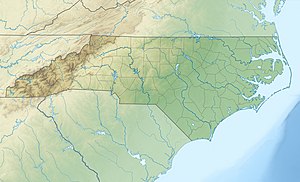Miry Hole Branch
Appearance
| Miry Hole Branch Tributary to Trent River | |
|---|---|
| Location | |
| Country | United States |
| State | North Carolina |
| County | Jones |
| Physical characteristics | |
| Source | Reedy Branch divide |
| • location | about 2 miles south of Trent Woods, North Carolina |
| • coordinates | 35°03′19″N 077°07′31″W / 35.05528°N 77.12528°W[1] |
| • elevation | 15 ft (4.6 m)[2] |
| Mouth | Trent River |
• location | about 0.5 miles east of River Bend, North Carolina |
• coordinates | 35°03′43″N 077°08′20″W / 35.06194°N 77.13889°W[1] |
• elevation | 0 ft (0 m)[3] |
| Length | 0.91 mi (1.46 km)[4] |
| Basin size | 1.44 square miles (3.7 km2)[5] |
| Discharge | |
| • location | Trent River |
| • average | 2.29 cu ft/s (0.065 m3/s) at mouth with Trent River[5] |
| Basin features | |
| Progression | Trent River → Neuse River → Pamlico Sound → Atlantic Ocean |
| River system | Neuse River |
| Tributaries | |
| • left | unnamed tributaries |
| • right | unnamed tributaries |
| Bridges | Crump Farm Road |
Miry Hole Branch is a 0.92 mi (1.48 km) long 1st order tributary to the Trent River in Jones County, North Carolina. This is the only stream of this name in the United States.[1]
Course[edit]
Miry Hole Branch rises about 2 miles south of Trent Woods, North Carolina and then flows northwest to join the Trent River about 0.5 miles east of River Bend.[3]
Watershed[edit]
Miry Hole Branch drains 1.44 square miles (3.7 km2) of area, receives about 54.7 in/year of precipitation, has a wetness index of 528.11, and is about 47% forested.[5]
See also[edit]
References[edit]
- ^ a b c "GNIS Detail - Miry Hole Branch". geonames.usgs.gov. US Geological Survey. Retrieved 21 December 2020.
- ^ "Get Maps". USGS Topoview. US Geological Survey. Retrieved 21 December 2020.
- ^ a b "Get Maps". USGS Topoview. US Geological Survey. Retrieved 20 December 2020.
- ^ "ArcGIS Web Application". epa.maps.arcgis.com. US EPA. Retrieved 21 December 2020.
- ^ a b c "Miry Hole Branch Watershed Report". US EPA Geoviewer. US EPA. Retrieved 21 December 2020.


